1. <ol>
<li style="margin-left: 36pt;">
Siegel RL, Miller KD, Wagle NS, Jemal A. Cancer statistics<em>.</em> <em>CA Cancer J Clin.</em> 2023;73(1): p.17-48.
<li style="margin-left: 36pt;">
De Groef A, Van Kampen M, Tieto E, et al. Arm lymphoedema and upper limb impairments in sentinel node-negative breast cancer patients: a one year follow-up study<em>.</em> <em>Breast.</em> 2016;29:p. 102-108.
<li style="margin-left: 36pt;">
Schmidt T, Berner J, Jonat W, et al. Influence of arm crank ergometry on development of lymphedema in breast cancer patients after axillary dissection: a randomized controlled trail.<em>J Rehabil Med</em>. 2017;49(1):78-83. doi:10.2340/16501977-2167
<li style="margin-left: 36pt;">
Kalder M, Hadji P. Breast cancer and osteoporosis - management of cancer treatment-induced bone loss in postmenopausal women with breast cancer.<em>Breast Care (Basel)</em>. 2014;9(5):312-317. doi:10.1159/000368843
<li style="margin-left: 36pt;">
Armer JM, Stewart BR. A comparison of four diagnostic criteria for lymphedema in a post-breast cancer population.<em>Lymphat Res Biol</em>. 2005;3(4):208-217. doi:10.1089/lrb.2005.3.208
<li style="margin-left: 36pt;">
Terada M, Yoshimura A, Sawaki M, et al. Patient-reported outcomes and objective assessments with arm measurement and bioimpedance analysis for lymphedema among breast cancer survivors.<em>Breast Cancer Res Treat</em>. 2020;179(1):91-100. doi:10.1007/s10549-019-05443-1
<li style="margin-left: 36pt;">
Iyigun G, Kirmizigil B, Angin E, et al. The reliability and validity of the Turkish version of Fullerton Advanced Balance (FAB-T) scale.<em>Arch Gerontol Geriatr</em>. 2018;78:38-44. doi:10.1016/j.archger. 2018.05.022
<li style="margin-left: 36pt;">
Hernandez D, Rose DJ. Predicting which older adults will or will not fall using the fullerton advanced balance scale<em>.</em> <em>Arch Phys Med Rehabil.</em> 2008;89(12):2309-2315.
<li style="margin-left: 36pt;">
Muir-Hunter SW, Clark J, McLean S, et al. Identifying balance and fall risk in community-dwelling older women: the effect of executive function on postural control.<em>Physiother Can</em>. 2014;66 (2):179-186. doi:10.3138/ptc.2013-16
<li style="margin-left: 36pt;">
Rose DJ, Lucchese N, Wiersma LD. Development of a multidimensional balance scale for use with functionally independent older adults.<em>Arch Phys Med Rehabil</em>. 2006;87(11): 1478-1485. doi:10.1016/j.apmr.2006.07.263
<li style="margin-left: 36pt;">
Yoosefinejad AK, Hadadi M, Eslamloo P. Evaluating the responsiveness of the fullerton advanced balance scale in patients with lymphedema secondary to breast cancer surgery.<em>Lymphology</em>. 2019;52(2):61-70.
<li style="margin-left: 36pt;">
Selcuk Yilmaz S, Ayhan FF. The randomized controlled study of low-level laser therapy, kinesio-taping and manual lymphatic drainage in patients with stage ii breast cancer-related lymphedema.<em>Eur J Breast Health</em>. 2023;19(1):34-44. doi:10.4274/ejbh.galenos.2022.2022-6-4
<li style="margin-left: 36pt;">
Huang MH, Lytle T, Miller KA, Smith K, Fredrickson K. History of falls, balance performance, and quality of life in older cancer survivors.<em>Gait Posture</em>. 2014;40(3):451-456. doi:10.1016/j.gaitpost. 2014.05.015
<li style="margin-left: 36pt;">
Winters-Stone KM, Dobek J, Bennett JA, Nail LM, Leo MC, Schwartz A. The effect of resistance training on muscle strength and physical function in older, postmenopausal breast cancer survivors: a randomized controlled trial.<em>J Cancer Surviv</em>. 2012; 6(2):189-199. doi:10.1007/s11764-011-0210-x
<li style="margin-left: 36pt;">
Foley Michael P, Scott M. Hasson. “Effects of a community-based multimodal exercise program on health-related physical fitness and physical function in breast cancer survivors: a pilot study.”<em>Integr Cancer Ther.</em>2016;15(4):446-454.
<li style="margin-left: 36pt;">
Lee CE, Warden SJ, Szuck B, Lau YJ. A preliminary study on the efficacy of a community-based physical activity intervention on physical function-related risk factors for falls among breast cancer survivors.<em>Am J Physical Med Rehab. </em>2016;<em>95</em>(8):561-570.
<li style="margin-left: 36pt;">
Evans ES, Ketcham CJ, Hibberd JC, Cullen ME, Basiliere JG, Murphy DL. Examination of clinical and laboratory measures of static and dynamic balance in breast cancer survivors.<em>Physiother Theory Pract</em>. 2021;37(11):1199-1209. doi:10.1080/09593985.2019.1692391
<li style="margin-left: 36pt;">
Basar S, Bakar Y, Keser I, et al. Does lymphedema affect the postural stability in women after breast cancer<em>?</em> <em>Topics in Geriatr Rehab.</em> 2012; 28(4): p. 287-294.
<li style="margin-left: 36pt;">
Angin S, Karadibak D, Yavuzşen T, Demirbüken I. Unilateral upper extremity lymphedema deteriorates the postural stability in breast cancer survivors.<em>Contemp Oncol (Pozn)</em>. 2014;18(4):279-284. doi:10.5114/wo.2014. 44120
<li style="margin-left: 36pt;">
Balzarini A, Lualdi P, Lucarini C, et al. Biomechanical evaluation of scapular girdle in patients with chronic arm lymphedema.<em>Lymphology</em>. 2006;39(3):132-140.
<li style="margin-left: 36pt;">
Singh D, Park W, Levy MS, Jung ES. The effects of obesity and standing time on postural sway during prolonged quiet standing.<em>Ergonomics</em>. 2009;52(8):977-986. doi:10.1080/ 00140130902777636
<li style="margin-left: 36pt;">
Fabris de Souza SA, Faintuch J, Valezi AC, et al. Postural changes in morbidly obese patients.<em>Obes Surg</em>. 2005;15(7):1013-1016. doi: 10.1381/0960892054621224
<li style="margin-left: 36pt;">
Wang L, Chen H, Li Y, et al. Body mass index increases the risk of breast cancer-related lymphedema at 6-18months after surgery: a retrospective study.<em>Support Care Cancer</em>. 2023;31(5):278. doi:10.1007/s00520-023-07721-7
<li style="margin-left: 36pt;">
Shen A, Lu Q, Fu X, et al. Risk factors of unilateral breast cancer-related lymphedema: an updated systematic review and meta-analysis of 84 cohort studies.<em>Support Care Cancer</em>. 2022;31(1):18. doi:10.1007/s00520-022-07508-2

